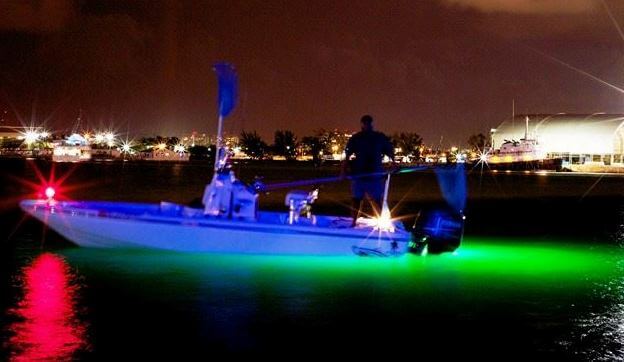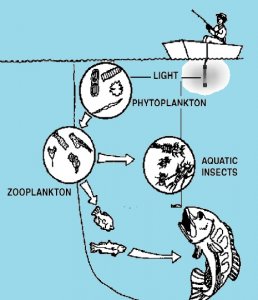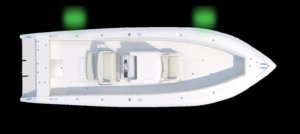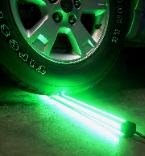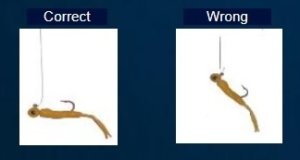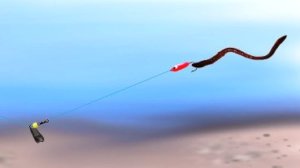How and Why Lights Attract Fish
FISHING with artificial light has been around for many years. In the early days the most common method was to hang a lantern over the side of a boat. Some of the old timers thought the light attracted bugs (which they did), and in return the fish surrounded the boat in hopes of getting a meal. There are still those who believe the old theory of more bugs, more fish, but new technology has done much to disprove that theory.
Projecting light in or on top of the water simply starts a natural food chain reaction by attracting a concentration of small microscopic animals called plankton. Bait fish such as shad and minnows are drawn to the light to feed on the plankton; and larger game fish move in to feed on the bait fish. It’s not uncommon to see bait fish stacked in columns 15 feet thick under the lights, with game fish suspended directly below them. If you do not have baitfish congregating around the light after 30 minutes, move to a different area. Game fish follow the baitfish, so don’t waste time in area’s that do not hold baitfish.
The Basics
Rods, lures, fish locator’s and Underwater Lights all help increase your chances of catching your limits on a daily basis, but they are not magic. In order for lights to attract fish, there has to be fish to attract. If the water is unsuitable to hold fish, not even lights will help lure fish into unhealthy water. Fish require good quality water, underwater structure to hide in and an open escape path into deeper water. If your dock is lacking any of these features, the number of fish you will attract to the light will be less.
Anchoring Your Boat
THE BOAT MUST BE ANCHORED IN ORDER FOR THE LIGHTS TO ATTRACT FISH!
When fishing at night anchoring your boat down is extremely important! In order to lock your boat down in one spot you need to use (2) anchor lines. Your primary anchor line can be on the front or rear and is the primary anchor point of the boat. However, you also need to use a secondary anchor which is dropped straight down on the opposite end of the boat. The secondary anchor is used to prevent the boat from pivoting on the main anchor line. If you are sitting on a break between 10’ and 50’ and want to anchor up in 15ft of water, you have to use the secondary anchor to prevent the boat from pivoting side to side on your primary anchor line which will allow the boat to drift in to deeper or shallower water.
Consider Depth and Structure
Depth and structure are the two most critical things you need to be thinking about when night fishing. Typically, fish always feed in shallower waters which are adjacent to deeper water. Drop offs around points or area’s close to the main river channel in lakes are the best locations to anchor up in. Water temperature, structure, and a fast escape route are the primary things fish are looking for when feeding, so think like a fish when locating a spot to anchor up in. Remember, water temperatures change daily in hot areas, so the spot that is good one night, may not be as good the next. Remember, 10% of the water in any lake holds 100% of the fish. The rest of the lake is dead water….with or without a lights. When locating a spot to fish, try to think like a fish. Fish always need an escape route, so structure is the most important think to be thinking about. An old river channel running through the lake is like a highway to other areas of the lake which provides cover and different depths of water for the fish to forage in. Ideally, a point or a bridge that has the old river channel running adjacent to it is hard to beat. Try and find a spot on the point where there is a good drop off. If the top depth is 10′ and drops to 50′ very fast, you would want to set up in 15′ to 25′ of water to start. If you don’t have any luck there, move deeper or shallower until you find the fish.
How Many Lights and How Deep
How many lights you use is totally dependent on how much money you want to spend. Lights are expensive, but if there will be 3 or 4 guys fishing from the boat you will probably need at least 2 lights. The below pictures show a (4) light set up (2-lights on each side) and a (2) light setup (1- light on each side) and (2- lights on the same side). Either scenario will work fine if you have 3 or 4 guys fishing. If using a light on each side of the boat, one person fishes on the right side of the light and the other person fishes on the left side of the light.
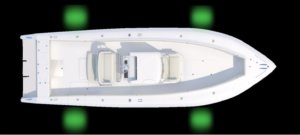
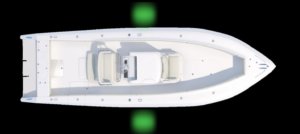
Do not put the lights in any deeper under the surface than 2’ to 3’. You always want to keep the baitfish high in the water as most fish look upward for their prey. Plus, if you put your light to deep in the water, there is a good chance the fish will get tangled up in the power-cord when you are bringing him in. Believe me, there is nothing worse than trying to untangle a fish from a light in the dark. Once the fish goes around the cord, it like a tetherball, around and around and there’s nothing you can do to stop it.
Attracting bait-fish is a MUST! If the bait fish do not show up in the first 30 minutes after setting your lights, move to another spot. Just because they weren’t at one spot doesn’t mean they won’t be at another spot further down the lake. Water temperature and oxygen content are key factors in attracting large numbers of bait fish. If your boat is sitting in good quality water which provides good structure, lights can attract baitfish by the thousands as shown below.
General Technique Used When Fishing Under the Lights
When fishing at night under the lights, always start at the bottom and slowly work you way up until you get a hit. The fish will suspend at the same depth all night, so once you find them, you simply go back to the same depth, and you will catch another. The easiest method of keeping track of the depth the fish are suspended in is to start at the bottom and work your way up.
-
Drop the lure to the bottom until your line goes slack. Drop your rod tip down to the top of the water (line still slack and lure on the bottom). Gradually reel up the slack in your line until it is tight, but the lure is still on the bottom. At this point you know when your rod tip is on the surface your lure is on the bottom.
-
At that point, stiffen your arm and raise your arm and rod tip up about 1’foot off the water and hold it still. Most bites come when the lure or bait is motionless.
-
If you don’t get a bite raise your arm another foot and hold it still. Continue to raise your arm in 1’ increments until your arm is straight out and horizontal to your body.
-
If you still have not gotten a bite, drop the rod drip back to the surface (lure on the bottom and slack in your line)
-
Put one complete crank on your reel and start moving your arm up again in 1’ increments again until your arm is once again horizontal to you.
Still not a bite, drop the rod tip back to the surface and put one more crank on the reel and begin moving up again. Remember to keep track of the number of cranks on the reel and the location your arm was in when you finally get a bite.
-
Once you catch a fish and know the depth the fish are suspended in, you simply start back at the bottom with the rod tip on top of the water and go back to the same spot. For example, say I caught my fish 1 crank off the bottom and my arm was in position 2, after unhooking the fish, I would go back to the bottom, put 1 crank on the reel and move my arm to position 2 which is where I caught the first fish. Many times, you can catch over 100 fish a night using this technique.
What is the Best Color to Use?
While GREEN is the most popular color of lights being used today, the color of light used can be as important as the color of fishing lure you use. Different colors of light travel further underwater than others in different conditions. Changing from White Light to Green Light could make all the difference in the world from the eyes of a fish. Again, just because Green Light may not be working on a particular night doesn’t mean White Light won’t. And sometimes using Both Colors combined is the best solution to getting a bite.
While our new SuperBrite X2 DUAL Color lights give you the option of using White, Green or Both Colors at the same time, our new SuperBrite 4800-C lights use all Green LEDs and project more overall GREEN Lumens than any of our SuperBrite lights.
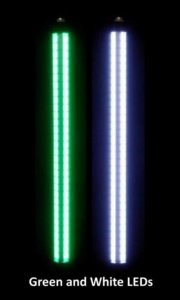
Lures and Bait
You should always try to use a lure or bait that looks like the baitfish in the water you are fishing. You can never go wrong using live bait dipped from the same water you are fishing in; however artificial baits work as well.
Keep in mind though, if you are using artificial lures, it is imperative to keep the lures looking as real as possible. If you are using a 1/8 oz. lead head jig with a rubber body, you want to make sure the jig ALWAYS hangs horizontal in the water. If the lure is hanging at an angle, it will greatly reduce the number of hits you have. So, take time to straighten your lure out after catching a fish, it will increase your strikes 10 fold.
Since the boat is motionless and the fish are suspended below the boat, their visibility is much greater than it would be if they were chasing bait in open water. So, lure and bait presentations are critical. Always use live bait or a similar artificial lure which is common to the water you are fishing in. It is important if using a lure to be sure and keep the lure positioned correctly so it hangs completely horizontal in the water. If the lure is hanging at a 45° angle you will catch 75% less fish. It makes a HUGE difference, so be sure and check you lure after catching a fish.
If you are fishing for Walleye or other bottom dwelling fish, you should always fish on the outer edge of the light. Walleyes are more skittish of the light and typically hang out on the outer edge of the light. I typically fish with a Puddle Jumper which is a split tailed rubber body on a 1/8oz jig or live minnow directly under the lights and then use a separate pole baited with a floating jig head and night crawler which I cast just beyond the edge of the light. This rig floats about 1’ off the bottom and lays stationery until a fish picks it up. You can use any floating jig head and squeeze a little split shot about 1’ above the lure which allows the worm to stay stationery about a foot off the bottom.
Tips That Might Help
- Typically, fish do not hit hard when fishing under the lights. Most of time, all you will feel is a slight peck when they bite and at that time you have to be ready to set the hook. If you are a second behind, you will lose him. I have fished with many people who though they weren’t getting bites, but in reality, they were, but just didn’t know it.
- If you are fishing for Walleye or other bottom dwelling fish, you should always fish on the outer edge of the light. Walleyes are more skittish of the light and typically hang out on the outer edge of the light. I typically fish my primary pole using an artificial lure (Puddle Jumper which is a split tailed rubber body on a 1/8oz jig) or live minnow directly under the lights and then use a separate pole baited with a floating jig head and night crawler which I cast just beyond the edge of the light. This rig floats about 1’ off the bottom and lays stationery until a fish picks it up. You can use any floating jig head and squeeze a little split shot about 1’ above the lure which allows the worm to stay stationery about a foot off the bottom.
- I prefer using 5½’ pole with 6 lb. test line. If the line is too heavy, they fish can see it under the light, so be sure to use “clear” 6lb test line. Be sure your pole is not too stiff, or you won’t be able to feel the bites. Most crappie rods with a good spinning reel work great for night fishing.

